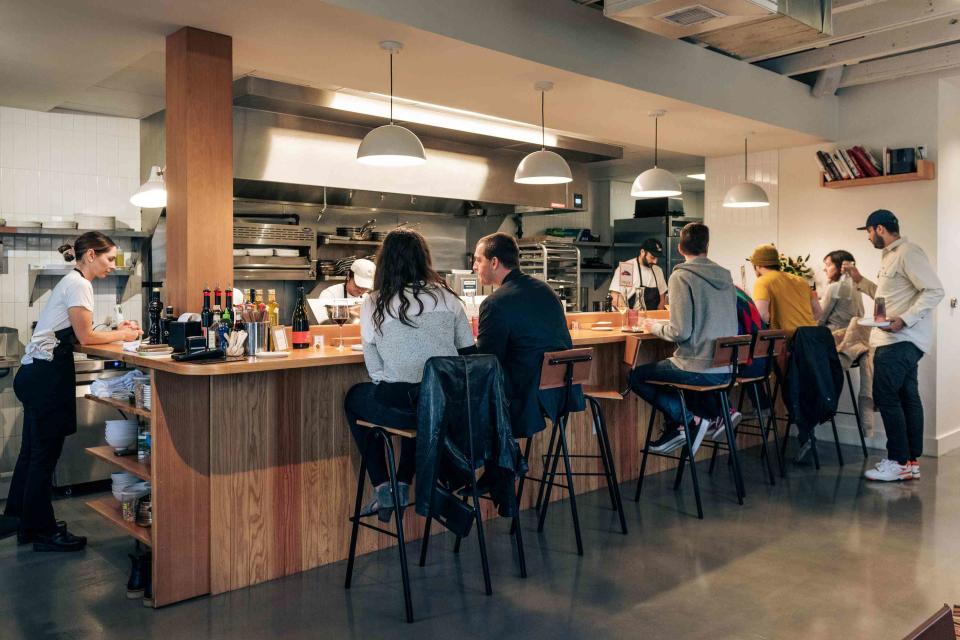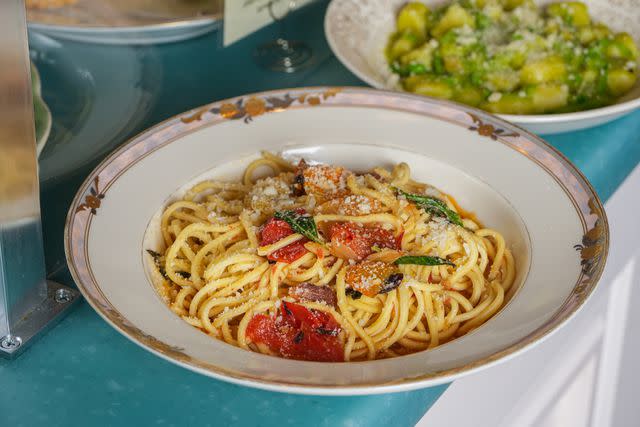Why Counter Service Restaurants Are Everywhere These Days
Restaurant operators are finding new ways to move forward in an industry already running on slim margins.

John Davidson
The counter at Birdie's in Austin.Watching owner Brooks Headley pour olive oil in the kitchen of Superiority Burger in New York, Tracy Malechek-Ezekiel had a realization. It was the same olive oil used at Del Posto, the Michelin-starred restaurant where both chefs had worked. But instead of gracing fine china plates set atop white tablecloths, Headley was pouring the fancy olive oil into paper boats that typically held dishes like preserved lemon chicory salad and malt cake with blueberry compote at his fast casual vegetarian burger restaurant.
“Whoever wrote the rules?” she remembers thinking. “Why do restaurants have to be a certain way?”
A few years later, Malechek-Ezekiel and her husband, sommelier and hospitality veteran Arjav Ezekiel, thought about what they’d want their own restaurant to look like—a fun place with great food, wine, and hospitality. Then they planned how to make it happen in the face of the industry’s soaring labor and food costs.
“We had to build this model from scratch knowing what we know today about the economics of restaurants,” says Ezekiel.
"“We had to build this model from scratch knowing what we know today about the economics of restaurants." — Arjav Ezekiel"
They signed a lease for a space in Austin just one month before Covid emerged, and opened Birdie’s in 2021. The restaurant and wine bar, named Food & Wine’s 2023 Restaurant of the Year, was inspired in part by places like Superiority Burger and Sqirl in Los Angeles, that married more ambitious food with a counter service model.
Related: How Technology Replaced Service in Fine Dining
In the last several years, counter service restaurants—i.e., where customers place their orders and pay at a counter or via QR code rather than being seated and served by waitstaff at a table—are proliferating. It’s thanks in part to pandemic-induced labor shortages, surging costs of food and labor, and an increasing consumer preference for convenience. In the coming years, the quick service restaurant sector is expected to continue to grow.
Some diners aren’t yet sold on the model; complaints include feeling hurried, a lack of service and story-telling about the menu, and tipping fatigue. Still, with 98% of operators reporting that higher labor is an issue for their restaurant, 97% citing higher food costs, and 38% reporting their restaurants were not profitable last year, according to the National Restaurant Association 2024 state of the industry report, change is necessary. It’s led some operators to rethink long-established rules about service and hospitality in a way that could reshape the restaurant industry.

Courtesy of StarChefs
Cardamaro and soft serve ice cream at Birdie's in Austin.At Birdie’s, which serves dinner Tuesday through Saturday, diners queue up to order at the counter, and find a table to await dishes like $24 orecchiette with field peas and pecorino and $19 beef tartare with a carta di musica. But although it’s technically a counter service model, Ezekiel and Malechek-Ezekiel have also been laser-focused on the diner experience.
Related: Mad About High Restaurant Prices? It's Not the Chef's Fault
“The layering of hospitality was the secret ingredient,” says Ezekiel. “People are coming in, arms crossed, with low expectations for what that piece would look like. And that's where you get an opportunity to blow their socks off a little bit.”

Mike Prince / Courtesy of Fiore
Two bowls of pasta on a counter at Fiore in Philadelphia.They do this with simple things, like refilling guests’ water glasses, clearing tables, and having the sommelier answer questions about the wine list. But they also might pour complimentary port for a couple celebrating a 20th anniversary, or sharing a printed list of their favorite restaurants in the city with out-of-town visitors.
"“The biggest benefit is that we get to invest in our team." — Arjav Ezekiel"
The result? Not only is the business thriving, but, says Ezekiel, “The biggest benefit is that we get to invest in our team.” Staffers working more than 25 hours are included in the tip pool (tipping, notes Ezekiel, averages about 22%), employee health insurance and mental healthcare is subsidized, and employees get paid vacation while the restaurant closes for a month each year.
Ed Crochet and Justine MacNeil, the couple behind Philadelphia’s Fiore, reimagined their restaurant after the pandemic. On the heels of closing their four-year-old full service, 78-seat location in favor of a much smaller space, the chefs dropped dinner service. Now, diners order Italian-inspired pastries and egg sandwiches on freshly-baked focaccia for breakfast and housemade pastas and slow-cooked pork sandwiches at lunch, and take numbers to a table to await their food, served on floral ceramic dishware.
Related: What We Wish Restaurant Guests Knew About Tipping
Like Birdie’s, Fiore offers warm and efficient service, delivering drinks and food and clearing tables, but counter service made more sense in the smaller space with smaller check sizes. Also, Crochet adds, “The labor cost thing is real.” Restaurants turning to a more concentrated style of service, he says, are doing so “because the back of house employees now cost so much more money than they did before the pandemic.”
Still, the counter service model hasn’t been a fit for every restaurant. In Reno, Nevada, the recently-opened Madein was envisioned around a counter service model, says co-owner Rachel Macintyre. Payroll was a main factor, but the owners were also inspired by Grassa in Portland, a no-frills counter service model serving elevated Italian dishes.
“We really wanted to create this fine dining-meets-fast casual experience,” Macintyre says. But after the first night of the restaurant’s friends and family soft opening, they pivoted to table service for dinner. “In larger urban communities like Portland, where Grassa is located, [counter service] is becoming more common,” she says. “It's not here in Reno. There are maybe three restaurants that do it, so it's just new, and I think that caused a lot of confusion.”
What’s more, the Madein team felt that without the added facetime with servers, they were missing out on storytelling about the menu items like Black Rabbit mead, made with honey from the nearby Sierra Nevada mountains, that make the restaurant special. They were also warned diners wouldn’t tip as well on counter service—a prediction they’ve seen play out. Until recently, Madein was still offering counter service at lunch, and although menu prices at lunch and dinner are roughly the same, the average tip hovered around 10%, while table service dinner clocks in around 25%.
Related: The Customer Is Not Always Right
As restaurants continue to run on slim margins, operators continue to find new ways to build businesses that work.
“Tracy and I really believe in counter service, but we also believe counter service is one possible solution to some of the problems that restaurants are facing on the financial side,” says Ezekiel. “There are other ways to also solve it based on which market you're in.”
With that said, the couple has recently fielded inquiries from several operators in different states seeking to learn about the Birdie’s model.
“I think a lot of people see this as the future of restaurants,” he said.
For more Food & Wine news, make sure to sign up for our newsletter!
Read the original article on Food & Wine.


